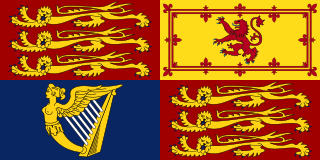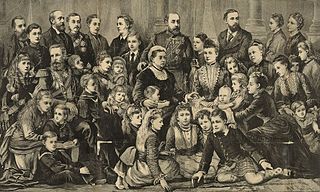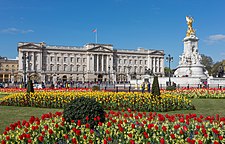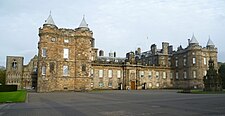
Buckingham Palace is a royal residence in London and the administrative headquarters of the monarch of the United Kingdom. Located in the City of Westminster, the palace is often at the centre of state occasions and royal hospitality. It has been a focal point for the British people at times of national rejoicing and mourning.

The monarchy of the United Kingdom, commonly referred to as the British monarchy, is the constitutional form of government by which a hereditary sovereign reigns as the head of state of the United Kingdom, the Crown Dependencies and the British Overseas Territories. The current monarch is King Charles III, who ascended the throne on 8 September 2022, upon the death of his mother, Queen Elizabeth II.

Mary of Teck was Queen of the United Kingdom and the British Dominions, and Empress of India, from 6 May 1910 until 20 January 1936 as the wife of King-Emperor George V.

The Most Noble Order of the Garter is an order of chivalry founded by Edward III of England in 1348. The most senior order of knighthood in the British honours system, the only decorations which outrank it in precedence are the Victoria Cross and the George Cross. The Order of the Garter is dedicated to the image and arms of Saint George, England's patron saint.

The Royal Standards of the United Kingdom presently refer to either of two similar flags used by King Charles III in his capacity as Sovereign of the United Kingdom, the Crown dependencies, and the British Overseas Territories. Two versions of the flag exist, one for use within Scotland and the other for use elsewhere.

Prince Adolphus, Duke of Cambridge, was the tenth child and seventh son of King George III and Queen Charlotte of the United Kingdom. He held the title of Duke of Cambridge from 1801 until his death. He also served as Viceroy of Hanover on behalf of his brothers George IV and William IV.

Prince Augustus Frederick, Duke of Sussex, was the sixth son and ninth child of King George III and his queen consort, Charlotte of Mecklenburg-Strelitz. He was the only surviving son of George III who did not pursue an army or navy career. A Whig, he was known for his liberal views, which included reform of Parliament, abolition of the slave trade, Catholic Emancipation, and the removal of existing civil restrictions on Jews and Dissenters.

Princess Augusta of Cambridge was a member of the British royal family, a granddaughter of George III. She married into the Grand Ducal House of Mecklenburg-Strelitz and became Grand Duchess of Mecklenburg-Strelitz.

St James's Palace is the most senior royal palace in London, the capital of the United Kingdom. The palace gives its name to the Court of St James's, which is the monarch's royal court, and is located in the City of Westminster in London. Although no longer the principal residence of the monarch, it is the ceremonial meeting place of the Accession Council, the office of the Marshal of the Diplomatic Corps, and the London residence of several members of the royal family.

Clarence House is a royal residence on The Mall in the City of Westminster, London. It was built in 1825–1827, adjacent to St James's Palace, for the royal Duke of Clarence, the future king William IV.

The Coronation Chair, also known as St Edward's Chair or King Edward's Chair, is an ancient wooden chair on which British monarchs sit when they are invested with regalia and crowned at their coronations. It was commissioned in 1296 by King Edward I to contain the coronation stone of Scotland—known as the Stone of Destiny—which had been captured from the Scots. The chair was named after Edward the Confessor and was kept in his shrine at Westminster Abbey.

Kew Palace is a British royal palace within the grounds of Kew Gardens on the banks of the River Thames. Originally a large complex, few elements of it survive. Dating to 1631 but built atop the undercroft of an earlier building, the main survivor is known as the Dutch House. Its royal occupation lasted from around 1728 until 1818, with a final short-lived occupation in 1844. The Dutch House is Grade I listed, and open to visitors. It is cared for by an independent charity, Historic Royal Palaces, which receives no funding from the government or the Crown. Alongside the Dutch House is a part of its 18th-century service wing, whilst nearby are a former housekeeper's cottage, brewhouse and kitchen block – most of these buildings are private, though the kitchens are open to the public. These kitchens, the Great Pagoda and Queen Charlotte's Cottage are also run by Historic Royal Palaces.

A throne room or throne hall is the room, often rather a hall, in the official residence of the crown, either a palace or a fortified castle, where the throne of a senior figure is set up with elaborate pomp—usually raised, often with steps, and under a canopy, both of which are part of the original notion of the Greek word thronos.

The Royal Archives, also known as the Queen's or King's Archives, is a division of The Royal Household of the Sovereign of the United Kingdom. It is operationally under the control of the Keeper of the Royal Archives, who is customarily the Private Secretary to the Sovereign. Although sovereigns have kept records for centuries, the Royal Archives was formally established as recently as 1912 and occupies part of the Round Tower of Windsor Castle. Since the Royal Archives are privately owned, requests for public access must be approved based on the needs and qualifications of the researcher.

Windsor Castle is a royal residence at Windsor in the English county of Berkshire. It is strongly associated with the English and succeeding British royal family, and embodies almost a millennium of architectural history.

The Royal Collection of the British royal family is the largest private art collection in the world.

Queen Victoria, the British monarch from 1837 to 1901, and Prince Albert had 9 children, 42 grandchildren, and 87 great-grandchildren.

The Palace of Holyroodhouse, commonly referred to as Holyrood Palace or Holyroodhouse, is the official residence of the British monarch in Scotland. Located at the bottom of the Royal Mile in Edinburgh, at the opposite end to Edinburgh Castle, Holyroodhouse has served as the principal royal residence in Scotland since the 16th century, and is a setting for state occasions and official entertaining.

St George's Chapel at Windsor Castle in England is a castle chapel built in the late-medieval Perpendicular Gothic style. It is a Royal Peculiar, and the Chapel of the Order of the Garter. St George's Chapel was founded in the 14th century by King Edward III and extensively enlarged in the late 15th century. It is located in the Lower Ward of the castle.

In the United Kingdom state funerals are usually reserved for monarchs. The most recent was the state funeral of Queen Elizabeth II on 19 September 2022.























